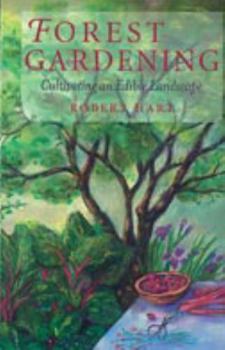Forest Gardening: Cultivating an Edible Landscape, 2nd Edition
Select Format
Select Condition 
Book Overview
Forest gardening is a way of working with nature which is not only productive and requires minimal maintenance, but also has fantastic environmental benefits. You don't need a forest for forest... This description may be from another edition of this product.
Format:Paperback
Language:English
ISBN:0930031849
ISBN13:9780930031848
Release Date:September 1996
Publisher:Chelsea Green Publishing Company
Length:234 Pages
Weight:1.50 lbs.
Dimensions:0.6" x 5.8" x 8.6"
Customer Reviews
4 ratings
Inspirational Read for the Self-Sustainer
Published by Thriftbooks.com User , 16 years ago
I absolutely loved this book. I have studied plants and home gardening for 25 years and felt this was an excellent read for anyone interested in complete self-sufficiency or needing the background and impetus for forest gardening. Sure, the author goes into great detail about other civilations' - past and present - forms of forest gardening, and he also touches on the art of craft, and through his own plight, the unnecessary and quite wasteful use of land for modern and/or animal agriculture. A good starter book for permaculturists, as he cites many other authors and books from which one could learn. The author clearly has spent decades developing and researching forest gardens and appreciating nature (Gaia as he calls it) and a return to harmony within it. Highly recommended!
Inspiring but not Practical
Published by Thriftbooks.com User , 20 years ago
Robert Hart's book on Forest Gardening is very inspiring, but more research is needed to start your garden. The list of suppliers in the Appendix is very helpful for those in North America, and the list of cultivars includes little known but very useful varieties. Overall, the book helps one understand the why of forest gardening but not the how to.
Everyone can profit from this book
Published by Thriftbooks.com User , 20 years ago
If you have not yet read 'Forest Farming' by Douglas and Hart, then you may lack the background to fully appreciate this book. In 'Forest Farming' we are told that civilized man has marched across the face of the earth and left a desert in his footprints primarily because he has ploughed the hills with the loss of top soil. Crop-yielding trees offer the best medium for extending agriculture to hills, steep places, rocky places, and to the lands where rainfall is deficient. Every good Buddhist plants and sees the establishment of one tree at least every five years and this simple act multiplied six billion times would have a greater economic benefit for humankind than traditional development plans. The 'tool' with the greatest potentials for feeding men and animals, for regenerating the soil, for restoring water-systems, for controlling floods and droughts, for creating more benevolent micro-climates and more comfortable and stimulating living conditions for humanity, is the tree. Douglas and Hart point out that the deeper problem is ignorance as many crop-yielding trees and shrubs are currently ignored by farmers because agriculture in most parts of the world is geared to cereal growing and livestock rearing by conventional means, despite the fact that trees offer higher yields per acre. If the tree growing potentialities of city private gardens was fully recognized, suburban areas would not only have purer air and a more benevolent microclimate but a greater degree of self-sufficiency. In this book Hart develops the case for the urban dweller to adopt forest gardening to achieve economy of space and labor while producing fruit, nuts, root and perennial vegetables and herbs. He provides the guidelines required for temperate, tropical and sub-tropical climates. "Like the forest it is arranged in seven 'storeys', with the original apple and pear trees constituting the 'canopy' and the other plants occupying the lower tiers. Thus the garden has a well-defined vertical dimension as well as horizontal ones. Now that it has been established for several years, I can affirm that it requires minimal maintenance, as the plants - nearly all perennials - largely look after themselves and are very healthy. The main work involved is that of cutting back plants that try to encroach on others. The wide diversity of species ensures that any small invasions of pests never reach epidemic proportions, as they tend to do under monocultural conditions. The large number of aromatic herbs creates a deliciously fragrant atmosphere, and, I am convinced, contributes to the pest-and-disease-resistance of the other plants. As we eat the herbs and perennial vegetables daily in our salads, the garden makes a significant contribution to our diet throughout the growing season, from the first herbs and wild garlic in March to the last apples in November."The author goes on to warn us that we must seek ordered diversity governed by the laws of plant symbiosis but the results can b
A forest for every home!
Published by Thriftbooks.com User , 24 years ago
Since reading Robert Hart's classic book I have seen forest gardens sustaining life in Mexico, Fiji, Australia, South Africa and Britain. Around the world perennial 'home gardens' have been grown for millennia. Yet in temporate climates we seem to have forgotten how. This book has inspired me to increase the diversity and productivity of my own small garden in England, so far with good results. It is inspirational, but it is also practical. The Appendices offer suggestions for a variety of uses and climates. I would recommend as a companion volume, Patrick Whitefield's 'How to Grow a Forest Garden' for further details of the practicalities. But Hart's desciption of his own forest garden at Wenlock Edge stands alone and is an invaluable guide to practical sustainability.






